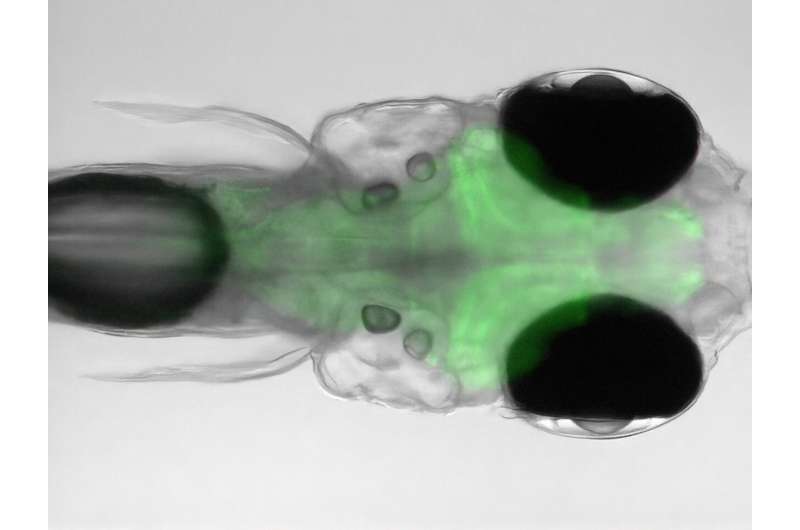Head of a zebrafish larva. The transparent nature of these animals allows their brain to be identified under the microscope. It is colored green in the image because it produces a dye that lights up green during neuron activity. Credit: Portugues Laboratory/TUM
Zebrafish are smaller than your little finger, with a brain no more than half the size of a pinhead. Yet these animals possess an efficient navigation system that enables them to find their way back to spots in the water where the temperature suits them.
This has been revealed in a recent study by the University of Bonn and University Hospital Bonn together with the Technical University of Munich (TUM), whose findings have been published in the journal Current Biology.
All animals need to regulate their body temperature and cannot survive for long if it gets too high or too low. Warm-blooded organisms like humans have various ways to do this. They release heat by sweating or expanding the blood vessels in their skin, while shivering or burning fat in their brown adipose tissue has the opposite effect.
Cold-blooded animals such as the zebrafish, by contrast, cannot do any of these, so they have a different strategy. They look for places nearby that are at their "comfortable temperature," just like how we might go out into the sun when we feel chilly or seek out some shade once it gets too hot.
"We formed the idea that cold-blooded organisms use similar brain mechanisms to humans to find the ideal temperature conditions for them and that these help them to know where to go," explains Professor Ilona Grunwald Kadow from the Institute of Physiology II at the University of Bonn and the University Hospital Bonn.
Fish larvae observed 'thinking'
The zebrafish is perfect for testing this idea because its larvae are transparent. This allows scientists to look inside their brains while they perform certain tasks in the laboratory—and these researchers did just that.
"The animals had been genetically modified to make their nerve cells produce a dye," explains Grunwald Kadow from the University Hospital Bonn, who is also a member of the Transdisciplinary Research Area "Life & Health" at the University of Bonn. "This caused their neurons to light up when they were active, enabling us to see under the microscope which areas of their brains were working at that precise moment."
In their experiments, the researchers surrounded the animals with water that they made hotter or colder. "Then we watched to see how they'd react," Virginia Palieri explains. For her doctorate at TUM, she studied the degree of similarity between the mechanisms for regulating body temperature used by cold-blooded animals and their warm-blooded counterparts such as humans. "This told us that the fish prefer a temperature of 25.3°C. As soon as it got a few tenths of a degree cooler or warmer, they began to seek out more comfortable surroundings."
Brain of a living, swimming larva being stimulated with a range of water temperatures. Using a specific dye shows which neurons are activated by this stimulation as they light up brightly for a brief period. Credit: Grunwald Kadow Working Group/University of Bonn
'Satnav' increases the chances of finding ideal living conditions quickly
Two parts of their brain are activated in this process, the preoptic area of the hypothalamus (POA) and the dorsal habenula. The POA seems to be primarily responsible for detecting deviations from the fish's ideal temperature.
More information: Virginia Palieri et al, The preoptic area and dorsal habenula jointly support homeostatic navigation in larval zebrafish, Current Biology (2024). DOI: 10.1016/j.cub.2023.12.030
Provided by University of Bonn























